Animation DefinitionThe computerized technique through which still figures can be controlled in such a way that they appear to be moving is called animation. Emile Kohl, a French cartoonist, is known to be the father of cartoon animations. Animations are mostly used for entertainment purposes. 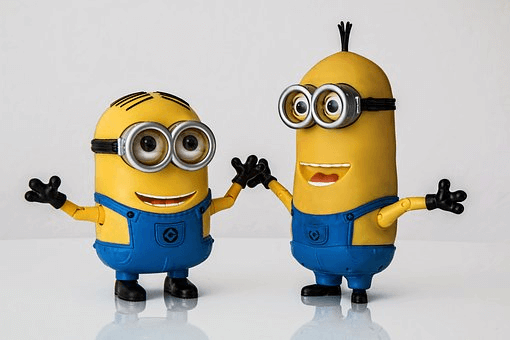
Some examples of animations are motion graphics and 3D animations. The simple way to develop an animation is by drawing an image or painting on a transparent celluloid sheet which can be used to make a film. Animations are quite popular among children and youngsters as they are created to humor their audience. The term "animation" is derived from the verb "to animate", which means to give life to something or illustration that can move. Applications of AnimationAt first, animations were developed only for entertainment purposes. However, with the advancement of technology, animations started to gain popularity among people of all age groups and sectors. Animations are created by blending art and technology together. Hence, the demand and opportunities for those who want to make a career in animation making are ever-increasing. The following are some notable sectors in which animation can be used to attract an audience: Gaming IndustryAnimation is important if you are considering starting a gaming company. Professional animators use 3D applications and tools to create characters, locations, and scenes and then combine all these with a good story to establish a gaming domain. Through the use of various computer programs, animation sequences can come to life frame by frame. It is important to take the type of game and follow-up into account so that storytelling features and character development can be added accordingly. The gaming industry is growing rapidly in the modern world as a part of the entertainment business. E-LearningThe animations created with the determined purpose of educational learning are known as educational animations. Many traditional methods of imparting education to children have been developed using animation tools. Websites such as YouTube and Udemy have flourished, and educators have found teaching platforms that are easy to access so they can create useful content by using animations. Through animated visuals, students can enhance their imagination and understand topics that they might find complex in written form. AR and VR AnimationsAugmented animation is the technology through which the user can experience the real and virtual worlds of digital animation blending together. The AR can be developed by using advanced visuals, sound effects, and sensory responses by holographic technology. Most people often get confused between Virtual Reality (VR) and Augmented Reality (AR) or consider them as same, but they are not. Virtual reality is a completely enveloping experience in which the audience losses their link with the physical world surrounding them. The 3D environment experienced by the consumer is generated through computerized simulation. One example of VR technology is the computer-generated simulation offered by Disney movies. AdvertisingAnimated ads can increase demand for a product through a 15 to 60-second showcase video. The commercial for advertisement should be creative and entertaining while emphasizing the importance of the product. Therefore, animations can be very effective in drawing the public's attention. For promoting digital marketing campaigns, animations can be significant because they add elements of entertainment to promotional videos. Many brands use animations for promotional campaigns via TV and social media. Making a choice between different styles of animations is an important task. For different purposes, different animations are used so that a selected audience can be targeted through these ads. The different notable styles of animation are as follows: 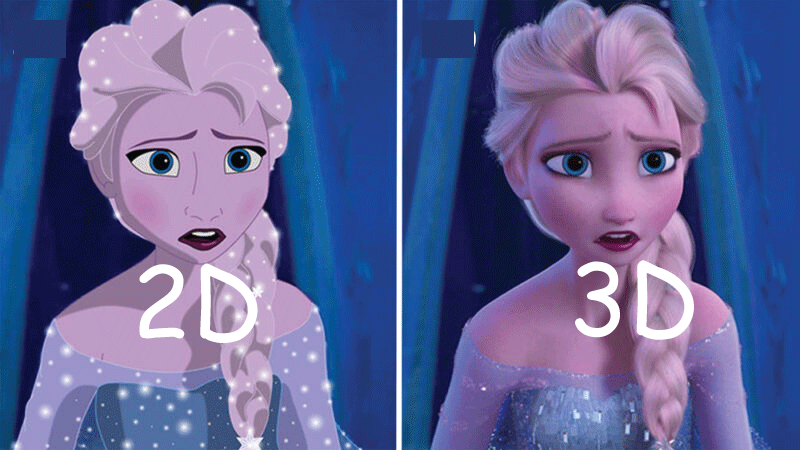
2D Animation2D animations are created by rapidly sequenced movements of two-dimensional images so that they appear as a lifelike illusion. The 2D animations can be traditionally drawn or computer-generated. Popular examples of 2D animations include cartoons like Loony Tunes, Tom and Jerry, and Disney Classics such as Cinderella, The Little Mermaid, and so on. The 2D animations can be included in presentations, marketing videos, and educational demonstrations, making such techniques more attractive and effective. Despite the availability of many modern techniques, 2D animation is gaining popularity again with cartoons and social media campaigns, and new content is being developed using 2D animation regularly. 3D AnimationThe 3D animations create an illusion for the viewers in which objects appear to be moving in a three-dimensional space. The 3D animated characters, space, and objects are more celebrated than 2D ones as they appear more realistic and captivating. Complicated actions such as explosions and flying weapons are created by using 3D techniques from advanced digital software. Movie makers and video game developers use 3D animation applications like Cinemachine to create high-quality scenes for their videos. Firstly, the artist has to create an environment where he/ she can add animated objects. Many keyframes are required to record or produce a 3D animation of a few seconds. Keyframes are snaps of the model of characters and objects from different angles and at different times. When these models are moved at specific time slots based on the requirements of the scene, the animation appears in 3D. Motion CaptureFor creating realistic action sequences, the animators use the process of motion capture. It is the modernized 3D technology that web developers use to create lifelike facial expressions and characters. For example- while making a film, the live actors are hired by the graphics team to dress up like the graphic characters. The actors use their facial expressions, sound effects, and live actions so that the naturalistic view of the combats can be recorded and modified graphically. The motion capture mechanism can be seen in movies such as Avengers and Avatar. The technique of motion capture is frequently used by video game developers to create many sets of motions for their aesthetical characters. Stop Motion AnimationThe flip-book style movements of animation are known as stop-motion animation. The still objects or models are photographed, and these photos are graphically moved in the frame by using advanced motion tools. When these frames are arranged in an order, the illusion is created where the images appear to be in motion on their own. The objects that are photographed are moved between the frames, so when they are played one after another, they seem to be moving in tandem. Therefore, it is also known as stop frame motion. In 1898, the first movie that was created by using stop motion was Humpty Dumpty Circus, directed by J. Stuart Blackton and Albert E Smith. Developing animations by using stop motion is not an easy process. This procedure is complex and time-consuming. Rotoscope AnimationThe animations that are developed by tracing the live-action video with a digital pen are called rotoscope animation. Once the characters or objects are drawn on the screen, they would move like real-life people. This animation process was first used in 1915 and was categorized as 2D animation. In the past, rotoscoping was done by hand and accomplished by hand, and tracing each detail on the frame was a tiring process. With modern technologies, advanced computer software is used to create rotoscopic illusions. The drawback of rotoscope animation is that the actions of the traced figures are limited to what is performed by the people in the real footage. Also, it is exhausting to shoot the footage first and then animate it. Besides, the details are essential in creating rotoscope animation. Mechanical AnimationThe 3D animations that are used to describe the functions, working processes, and modes of operations of a mechanical product are known as mechanical animations. The detailing process of various machines and their mechanisms can be difficult to understand just from inscribed form. Therefore, technological and engineering animators develop animations so that the audience can visualize the making and working process of mechanical gadgets and machines. These animations are used by industries like aircraft, health care, food appliances, and automobiles. Even the details that are mathematically associated with the machines are discussed in the mechanical animation videos. Principles of Animation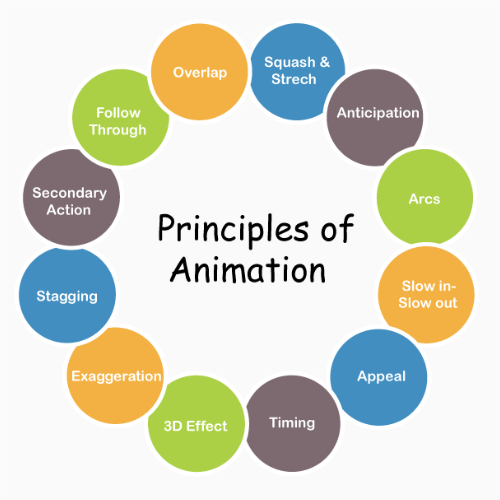
The principles of animation were first introduced by Disney animators in the 1930s. Even though the animation industries have developed throughout the years, these principles still lay the groundwork for all animated games and movies. The notable principles are given below: 1. Squash and StretchThis principle represents the change in the shape of figures and objects in the animation to get a touch of flexibility and spirit in the animation. Without this principle, the animation would look rigid and stiff. For example- a fast-moving rubber ball appears to be stretched in an animation video, and it squashes when it hits the ground. 2. AnticipationA short moment of action that comes right before the main action is known as the anticipation pose. In producing animations, anticipation plays an important role as it is the stage in which the figure in the frame gets ready to do something. For example- when a person squats before jumping or when a runner takes their position before they start running, these instances can be listed as anticipation poses. The anticipation poses add lifelike appeal to the animation. 3. StagingStaging consists of an organizational setup of everything that the viewer can see in the frame. The setting of the scene, the position of the characters, the accessories that are required in the presented situation, and the costumes need to match the plotline of the animation. Staging works as a presentation to attract the viewers, so they can decide if they are interested in the subject illustrated in the animation. The staging sets the audience's mood; e.g., if the staging includes a shady house with dead thatch in the front yard and a graveyard across from it, the audience may feel the anticipation of a scary experience. 4. Straight-ahead Action and Pose to Pose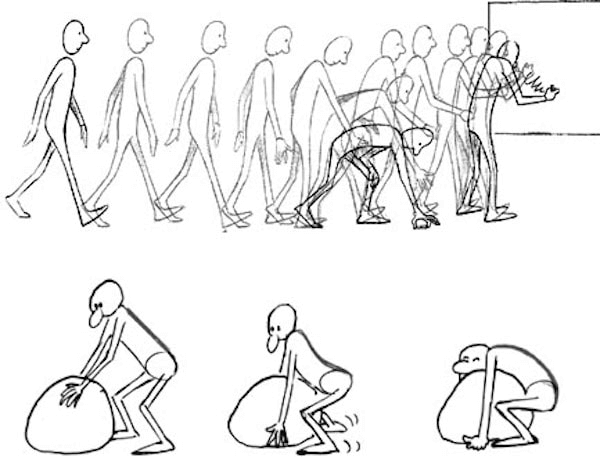
In animation, the artist draws the picture or drawing of every moment frame by frame until the end of the action. This principle is known as straight-ahead action. Alternatively, pose-to-pose is a technique in which the animator draws the main poses and leaves out the insignificant actions. Stop motion can be listed as a straight-ahead motion, and it requires expertise and patience to draw the designs scene by scene. 5. Follow through and OverlappingThe techniques like follow-through and overlapping are used to control the movement of characters and objects accordingly. If the actions illustrated in the graphic animation are not supported by the laws of physics, the actions would not appear realistic. Therefore, by using follow-through and overlapping action, the character can move in tandem with the objects. For example- when a ball is thrown by a person in reality, the action of swinging the hand backward and then forward to build momentum is a necessary action, and that should be kept in mind while converting it into an animation. 6. Slow in, Slow outThe object or figure should start by moving slowly and accelerate with time. Before coming to a stop, speed is decreased so the object can come to rest slowly. For the movements in animation to be observed clearly, it is important to know how slowly or rapidly the characters should move to emphasize a scene or action. For example- if leaves are falling from the tree, the timings need to be slow to symbolize a peaceful environment. 7. ArcIn an animation, circular actions are included so the movements of figures would appear realistic and graceful. Arcs could be created by a continuously bouncing ball, a spinning dancer, and swinging an arm. Arcs are significant tools to closely show the movements of objects from all angles. 8. Secondary ActionThe actions that are added in animation to emphasize the main action are known as secondary actions. These actions are included in the scene to make the viewer understand the extent of the character's situation or relate to the scene more closely. For example- a man taking a walk is just a typical walk. It is a simple action, and we don't get to know much about the setting. Now, if the man is bouncing his head up and down because he is listening to music while taking a walk, these actions could be used to determine his mood as well. 9. TimingThe speed of the action in animations is controlled by using this principle. To add realistic features to an animation, the timing and movements of objects need to match. The speed of actions cannot be too fast or too slow, or still for too long; otherwise, viewers will either get irritated or bored. For an animator, it is an important task to deduce the accurate timing in which action can take place. 10. ExaggerationExaggeration is the feature of animation in which the movements performed in the frame seem to have more effect than it is supposed to. It helps to add appeal to the action. While developing an animation, all effects and additions cannot be followed by actual reality and physics. Some actions are included to simply entertain the audience. 11. Solid Drawing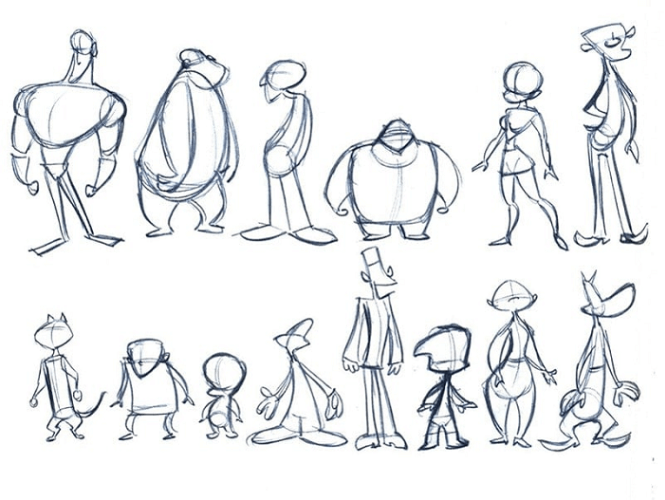
In the starting, the artist draws the outlines and rough sketches of materials and characters that are going to feature in the animation. It is done through a solid drawing. With this, the mass, volume, and height can be added to the drawings in a way so that they would appear to be 3-D accurately. The shapes, ellipses, and geometric forms are all used to create a solid drawing. The shapes and sizes of characters can even provide some understanding of their personality as well. 12. AppealThe style, voice, actions, and personality of each character are kept distinct from one another. The appeal of a character is formed on the basis of style and characteristics picked out by the animator. If a character is liked or his actions can be comprehended by the audience, the character is bound to have an appeal or charisma. The ConclusionAs concluded, animation refers to a technique using which static figures or objects can be manipulated so that they appear like moving images demonstrating a film. In other words, animation is considered to be the process through which stories and characters can come to life. It is one of the main sources of entertainment among the youth and is rapidly evolving with technologies such as Artificial Intelligence (AI) and Virtual Reality (VR)
Next TopicCVA Definition
|
 For Videos Join Our Youtube Channel: Join Now
For Videos Join Our Youtube Channel: Join Now
Feedback
- Send your Feedback to [email protected]
Help Others, Please Share










